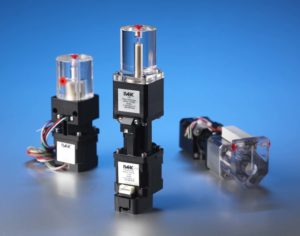 When deciding which OEM pump is best for precise aspirating and dispensing of samples and reagents in both Analytical and IVD instruments, we are often asked the differences between traditional Syringe Pumps and IVEK’s Ceramic Displacement Pumps. Since both of these can be used to do the same function, what are the pros and cons of each?
When deciding which OEM pump is best for precise aspirating and dispensing of samples and reagents in both Analytical and IVD instruments, we are often asked the differences between traditional Syringe Pumps and IVEK’s Ceramic Displacement Pumps. Since both of these can be used to do the same function, what are the pros and cons of each?
A traditional “Syringe Pump” is a device that uses a syringe (usually a glass barrel, gas tight syringe) as the essential pump for the mechanism. Using a “replaceable syringe” can have the advantage of replacing the syringe when it fails. You can also change syringe sizes to accommodate different volumes. The majority of “Syringe Pumps” work in conjunction with a motorized valve which the syringe attaches to. The timing of the syringe movements and the valve movements (two motors required) are controlled by built-in electronics.
In contrast, a Ceramic Displacement Pump is a single motor mechanism that utilizes an internal ceramic piston to precisely aspirate and dispense fluids. This style of pump is much simpler and less expensive than traditional Syringe Pumps. Since a glass barrel syringe is not used, there are no serviceable parts to these pumps. The internal sealing mechanism combined with the polished ceramic piston tend to last the entire life of the instrument, often exceeding 10 million cycles! Since internal valving is available as an option (usually two-way Solenoid Valves are used), Ceramic Displacement Pumps are specified to do exactly what is needed for each individual pipetting application within the instrument and method.
So, which style you should choose? This depends on your application(s) but here are some general guidelines:
Consider a Syringe Pump when:
- Your Instrument can benefit from being able to change syringes easily
- Your Instrument can benefit from have a multi-port distribution valve attached to the syringe
- Your instrument uses relatively low cycles during the life of the instrument
- Your instrument requires volumes greater than 5mls per aspirate/dispense cycle
Consider a Ceramic Displacement Pump when:
- Your Instrument will perform high cycles (many millions) over its lifetime
- Multiple pumps with specific functions are required within the instrument
- Instruments where the pump mechanism is not easily serviced or replaced
- Instruments requiring high precision without periodic service calls
- Applications where a single on/off valve on the inlet side is all the pump requires
If you have more questions about which pump style is right for your application, call us today. Our professional staff are always happy to help you.
